child seat OLDSMOBILE SILHOUETTE 1998 Owners Manual
[x] Cancel search | Manufacturer: OLDSMOBILE, Model Year: 1998, Model line: SILHOUETTE, Model: OLDSMOBILE SILHOUETTE 1998Pages: 444, PDF Size: 23.2 MB
Page 13 of 444
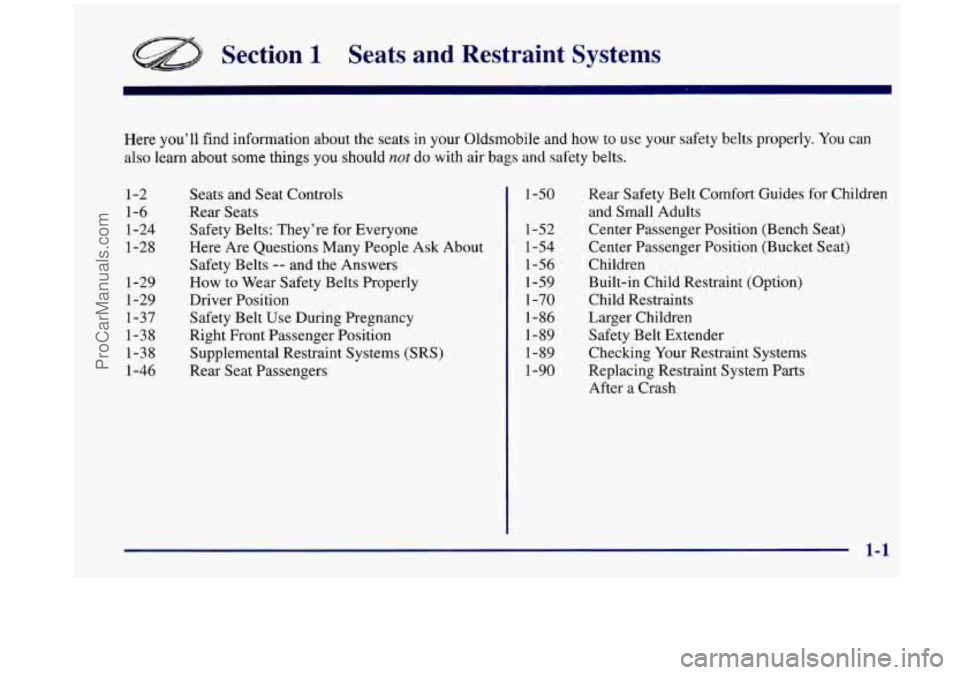
Section 1 Seats and Restraint Systems
Here you’ll find information about the seats in your Oldsmobile and how to use your safety belts properly. You can
also learn about
some things you should not do with air bags and safety belts.
1-2
1-6
1-24
1-28
1-29 1-29
1-37
1-38
1-38
1-46 Seats and Seat Controls
Rear Seats
Safety Belts: They’re for Everyone
Here Are Questions Many People Ask About
Safety Belts
-- and the Answers
How to Wear Safety Belts Properly
Driver Position
Safety Belt Use During Pregnancy
Right Front Passenger Position
Supplemental Restraint Systems (SRS)
Rear Seat Passengers
1-50
1-52
1-54 1-56
1-59
1-70 1-86
1-89
1-89
1-90 Rear Safety Belt Comfort Guides for Children
and Small Adults
Center Passenger Position (Bench Seat)
Center Passenger Position (Bucket Seat)
Children Built-in Child Restraint (Option)
Child Restraints
Larger Children
Safety Belt Extender
Checking Your Restraint Systems
Replacing Restraint System Parts After a Crash
1-1
ProCarManuals.com
Page 20 of 444

Split Bench Seats
If you have the split bench seat (50/50 or 40/60>, the
seatbacks can be folded down individually and the
sections can be removed individually. The sections can
also be adjusted forward or rearward individually.
The second row
(40/60) split bench may be equipped
with built-in child restraint(s). See “Built-In Child
Restraint” in the index.
Folding or Reclining the Seatbacks
To fold down the seatback on either section of the split
bench seat, pull the nylon strap
on the back of the seat or
lift up on the lever on the front
of the seatback.
To raise either seatback,
pull the nylon strap
on the
back
of the seat while
raising the seatback until
it
locks upright. Push and pull
on the seatback to check
that it is locked upright.
/ 0
0 7 ....... ...... ......... ........ ........... .......... .......... :-. ....... ”~ i -
Use the lever on the front of the seatback to raise or
lower the seatback to the desired position.
1-8
ProCarManuals.com
Page 27 of 444
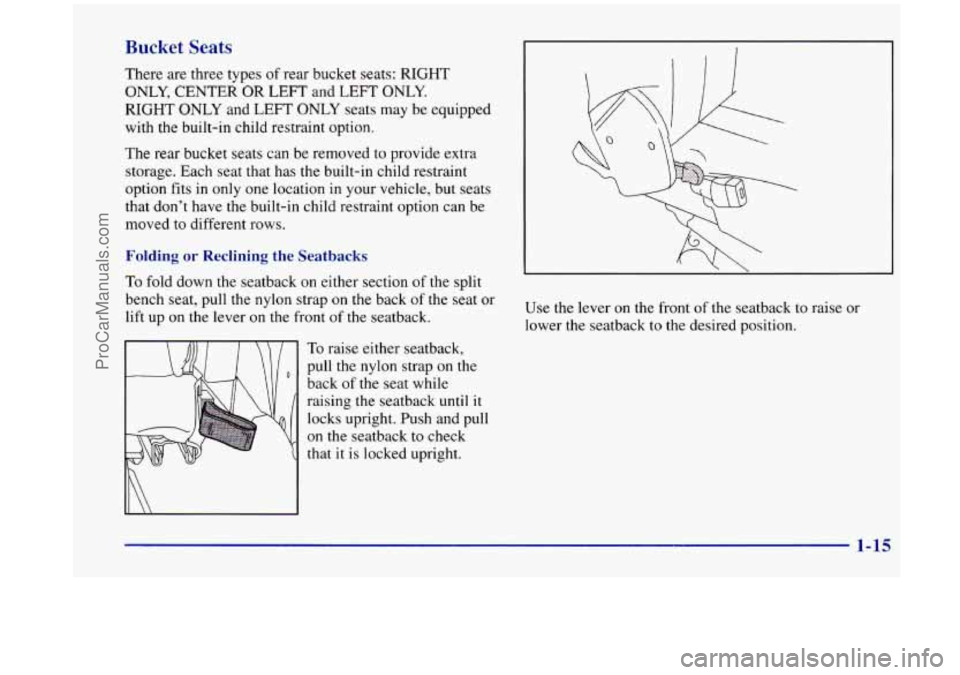
Bucket Seats
There are three types of rear bucket seats: RIGHT
ONLY, CENTER
OR LEFT and LEFT ONLY.
RIGHT ONLY and LEFT ONLY seats may be equipped
with the built-in child restraint option.
The
rear bucket seats can be removed to provide extra
storage. Each seat that has the built-in child restraint
option
fits in only one location in your vehicle, but seats
that don't have the built-in child restraint option can be
moved to different rows.
Folding or Reclining the Seatbacks
To fold down the seatback on either section of the split
bench seat, pull the nylon strap on the back of the seat or
lift up on the lever on the front
of the seatback.
To raise either seatback,
pull the nylon strap on the
back of the seat while
raising the seatback until it
locks upright. Push and pull
on the seatback to check
that
it is locked upright. Use
the lever
on the front of the seatback to raise or
lower the seatback to the desired position.
1-15
ProCarManuals.com
Page 31 of 444

Replacing the Bucket Seats
Don’t put the seats in so they face rearward because they
won’t latch that way. If you want more storage room
behind the seat, adjust the seat by sliding it forward.
The bucket seats have seat position labels, located on the
back
of the seat, showing where the seat must go. Follow
that diagram. See “Seat Controls” in the beginning of
this
section for more details. The seat must be placed in the
proper location for the legs
to attach correctly.
RIGHT
ONLY seats that don’t have the built-in child
restraint option fit only in the right location of either
row, the
E and F or I and J sets of floor cups.
The CENTER
OR LEFT seat fits in the center location
or in either left location, the
A and B, C and D or G
and H sets of floor cups.
The
LEFT ONLY seats that don’t have the built-in child
restraint option fit only in the left location of either row,
the
A and B or G and H sets of floor cups.
RIGHT ONLY seats that have the built-in child restraint
option fit only
in the right location of the second row,
the
E and F sets of floor cups.
LEFT ONLY seats that have the built-in child restraint
option fit only
in the left location of the second row, the
A and B sets of floor cups.
Make sure the seat is in the full rear position before
beginning this procedure.
1. With the seat folded, squeeze the angled gray bar
toward the solid gray crossbar while placing the
front hooks of the bench seat
onto the front two
floor pins.
To do this,
the seat will
need to be angled
so that
the front hooks clear the
floor pins.
1-19
ProCarManuals.com
Page 41 of 444
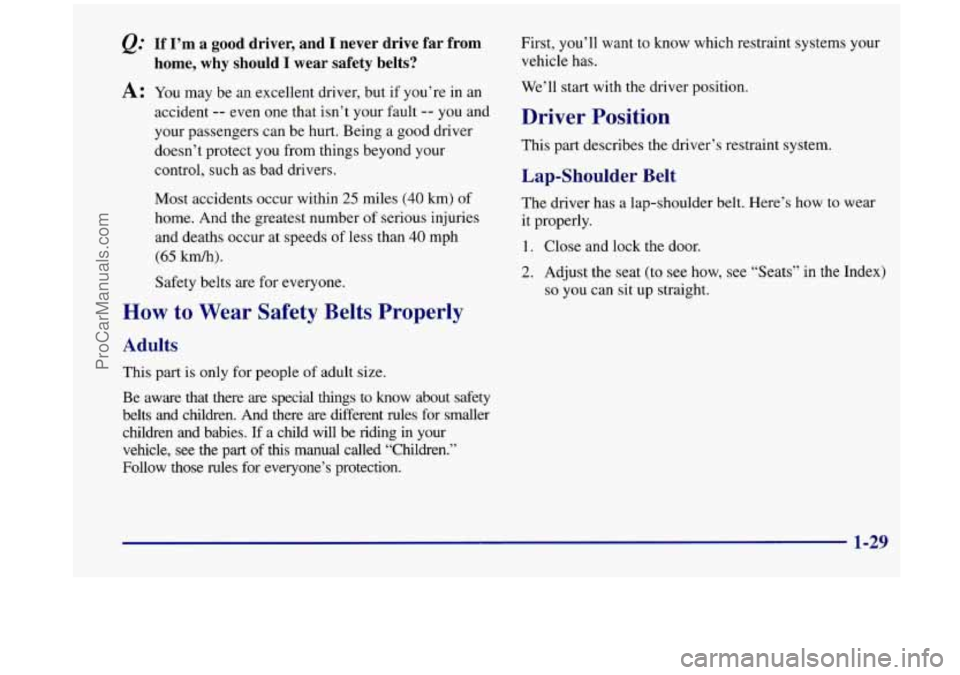
Q: If I’m a good driver, and I never drive far from
A: You may be an excellent driver, but if you’re in an
home, why should I wear safety belts?
accident -- even one that isn’t your fault -- you and
your passengers can be hurt. Being a good driver
doesn’t protect you from things beyond your
control, such as bad drivers.
Most accidents occur within
25 miles (40 km) of
home. And the greatest number of serious injuries
and deaths occur at speeds of less than
40 mph
(65 kdh).
Safety belts
are for everyone.
How to Wear Safety Belts Properly
Adults
This part is only for people of adult size.
Be aware that there
are special things to know about safety
belts and children. And there are different rules for smaller
children and babies. If a child will be riding
in your
vehicle, see the part of this manual called “Children.”
Follow those rules for everyone’s protection. First, you’ll want to know which restraint systems your
vehicle has.
We’ll start with the driver position.
Driver Position
This part describes the driver’s restraint system.
Lap-Shoulder Belt
The driver has a lap-shoulder belt. Here’s how to wear
it properly.
1. Close and lock the door.
2. Adjust the seat (to see how, see “Seats” in the Index)
so you can sit up straight.
1-29
ProCarManuals.com
Page 62 of 444
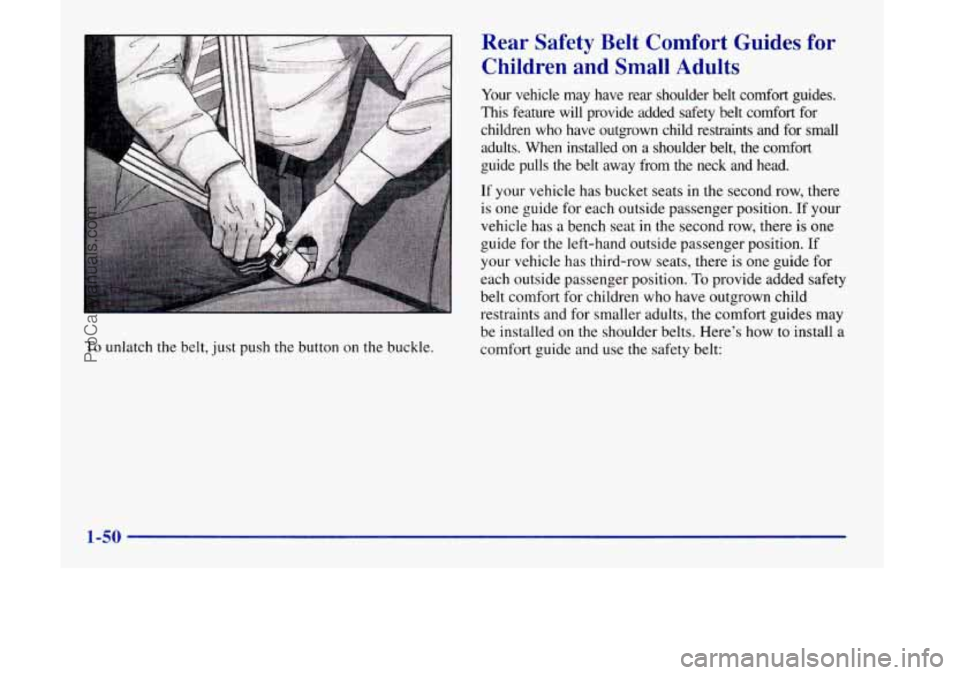
To unlatch the belt, just push the button on the buckle.
Rear Safety Belt Comfort Guides for
Children and Small Adults
Your vehicle may have rear shoulder belt comfort guides.
This feature will provide added safety belt comfort for
children who have outgrown child restraints and for small adults. When installed on
a shoulder belt, the comfort
guide pulls the belt away from the neck and head.
If your vehicle has bucket seats in the second row, there
is one guide for each outside passenger position. If your
vehicle has a bench seat in the second row, there is one
guide for the left-hand outside passenger position. If
your vehicle has third-row seats, there is one guide for
each outside passenger position.
To provide added safety
belt comfort for children who have outgrown child
restraints and for smaller adults, the comfort guides may
be installed on the shoulder belts. Here’s how to install a
comfort guide and use
the safety belt:
1-50
ProCarManuals.com
Page 68 of 444
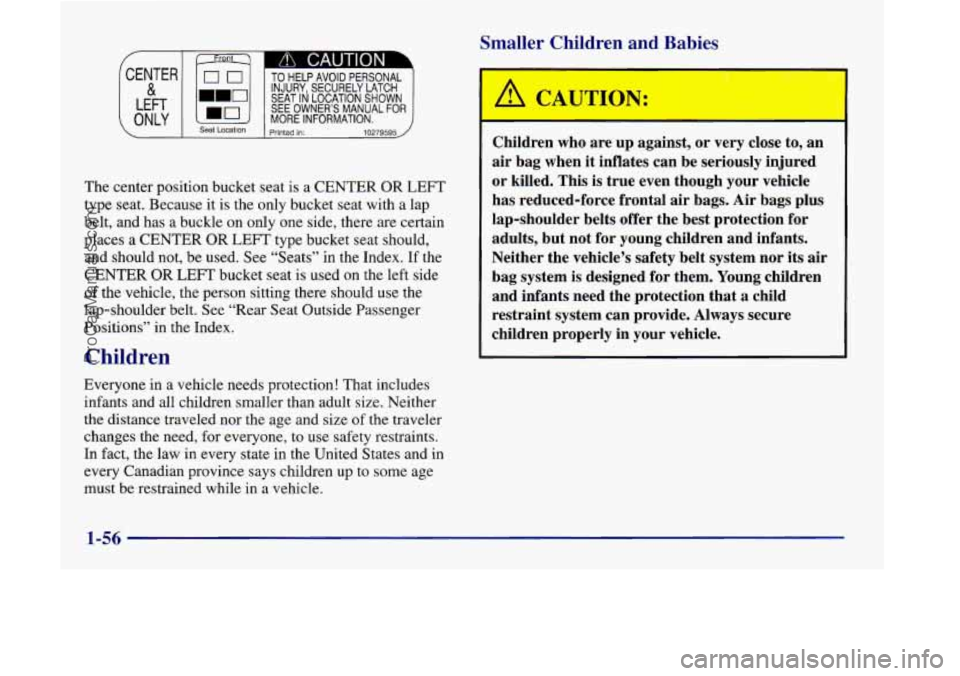
Smaller Children and Babies
c A CAUTION
TO HELP AVOID PERSONAL
SEAT IN LOCATION SHOWN
INJURY, SECURELY LATCH
SEE OWNER’S MANUAL
MORE INFORMATION. ONLY _. Seat Location printed in: 10279595
The center position bucket seat is a CENTER OR LEFT
type seat. Because it is the only bucket seat with a lap
belt, and has a buckle on only one side, there are certain
places a CENTER
OR LEFT type bucket seat should,
and should
not, be used. See “Seats” in the Index. If the
CENTER OR LEFT bucket seat
is used on the left side
of the vehicle, the person sitting there should use the
lap-shoulder belt.
See “Rear Seat Outside Passenger
Positions” in the Index.
Children
Children who are up against, or very close to, an
air bag when it inflates can be seriously injured
or killed. This is true even though your vehicle
has reduced-force frontal air bags.
Air bags plus
lap-shoulder belts offer the best protection for
adults, but not for young children and infants.
Neither the vehicle’s safety belt system nor its air
bag system is designed for them. Young children
and infants need the protection that
a child
restraint system can provide. Always secure
children properly in your vehicle.
Everyone in a vehicle needs protection! That includes
infants and all children smaller than adult size. Neither
the distance traveled nor the age and size
of the traveler
changes the need, for everyone, to use safety restraints.
In fact, the law in every state in the United States and
in
every Canadian province says children up to some age
must be restrained while in a vehicle.
1-56
ProCarManuals.com
Page 71 of 444
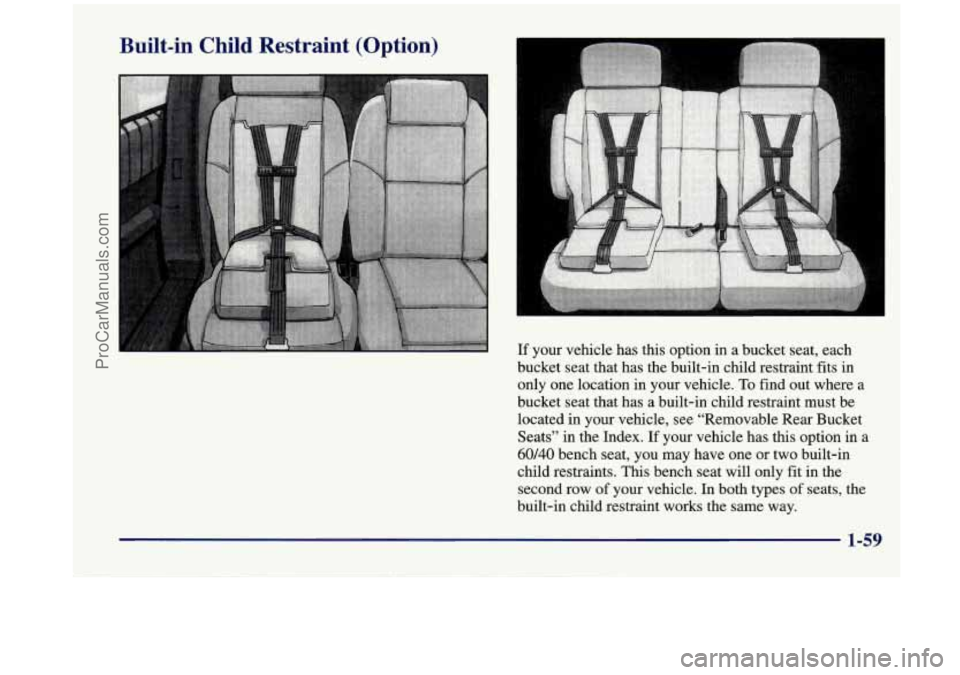
Built-in Child Restraint (Option)
If your vehicle has this option in a bucket seat, each
bucket seat that has the built-in child restraint fits in
only one location in your vehicle.
To find out where a
bucket seat that has a built-in child restraint must be
located in your vehicle, see “Removable Rear Bucket
Seats” in the Index.
If your vehicle has this option in a
60/40 bench seat, you may have one or two built-in
child restraints.
This bench seat will only fit in the
second row
of your vehicle. In both types of seats,
built-in child restraint works the same way. the
1-59
ProCarManuals.com
Page 72 of 444
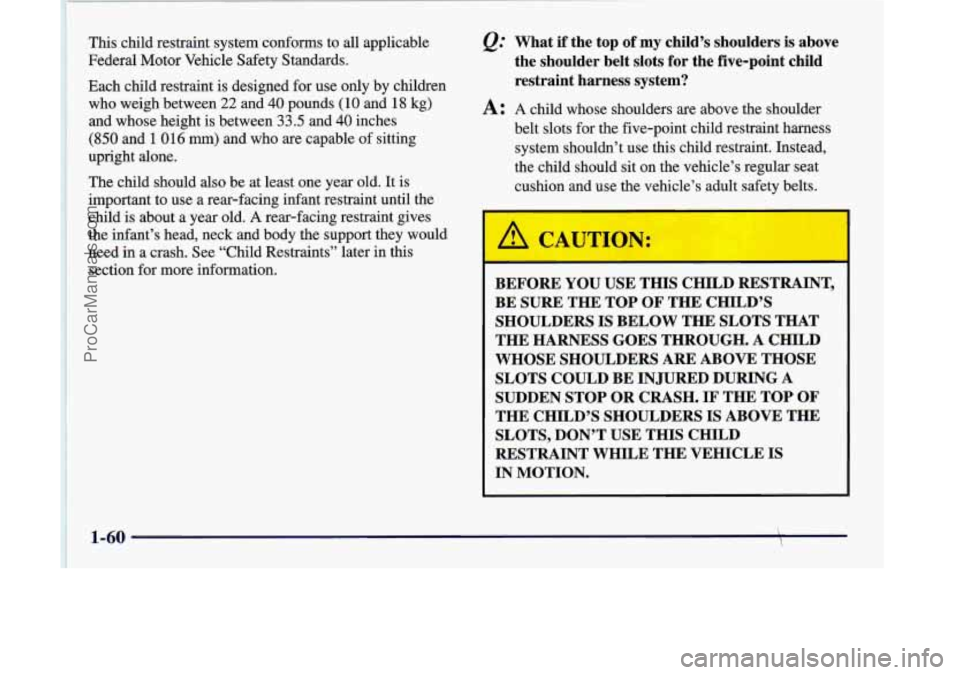
This child restraint system conforms to all applicable
Federal Motor Vehicle Safety Standards.
Each child restraint is designed for use only by children
who weigh between
22 and 40 pounds (10 and 18 kg)
and whose height is between 33.5 and 40 inches
(850 and 1 016 mm) and who are capable of sitting
upright alone.
The child should
also be at least one year old. It is
important to use a rear-facing infant restraint until the
child is about a year old.
A rex-facing restraint gives
the infant’s head, neck and body the support they would
need in a crash. See “Child Restraints” later in this
section for more information.
&: What if the top of my child’s shoulders is above
the shoulder belt slots for the five-point child
restraint harness system?
A: A child whose shoulders are above the shoulder
belt slots for the five-point child restraint harness
system shouldn’t use
this child restraint. Instead,
the child should sit
on the vehicle’s regular seat
cushion and use the vehicle’s adult safety belts.
BEFORE YOU USE THIS CHILD RESTRAINT,
BE SURE THE TOP
OF THE CHILD’S
SHOULDERS
IS BELOW THE SLOTS THAT
THE HARNESS GOES THROUGH.
A CHILD
WHOSE SHOULDERS ARE ABOVE THOSE
SLOTS COULD BE INJURED DURING
A
SUDDEN STOP OR CRASH. IF THE TOP OF
THE CHILD’S SHOULDERS IS ABOVE THE
SLOTS, DON’T USE
THIS CHILD
RESTRAINT WHILE THE VEHICLE
IS
IN MOTION.
1-60
ProCarManuals.com
Page 73 of 444
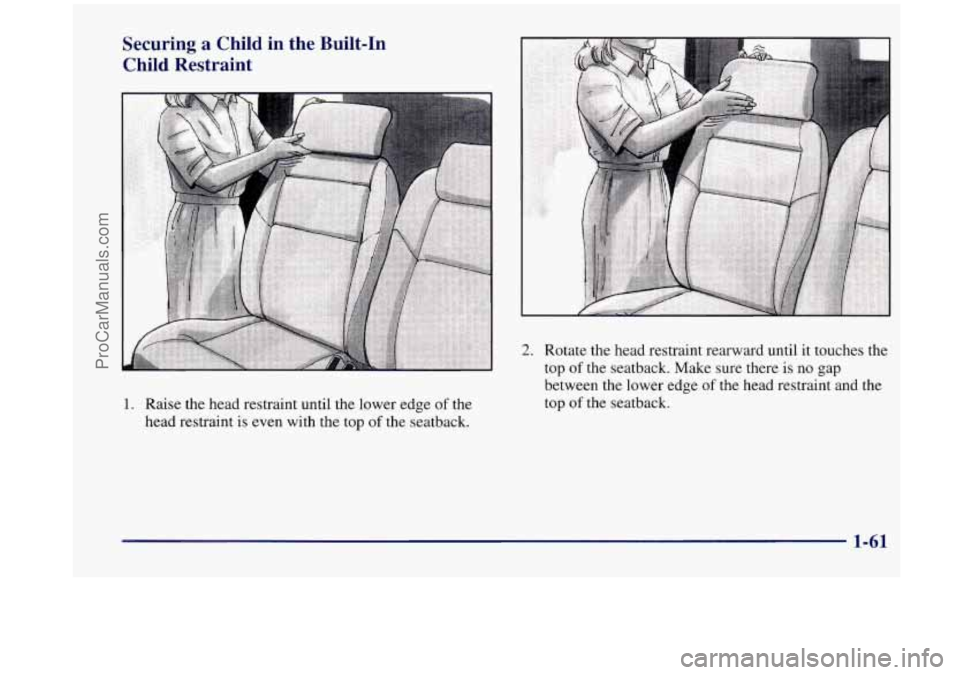
Securing a Child in the Built-In
Child Restraint
1. Raise the head restraint until the lower edge of the
head restraint is even with the top
of the seatback.
2. Rotate the head restraint rearward until it touches the
top
of the seatback. Make sure there is no gap
between the lower edge
of the head restraint and the
top
of the seatback.
1-61
ProCarManuals.com